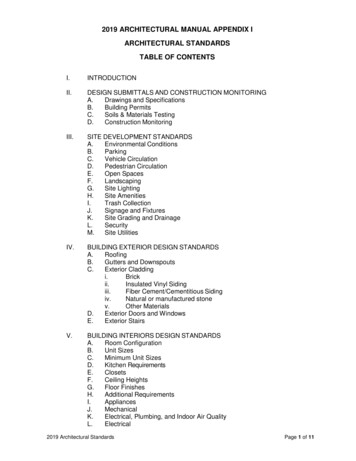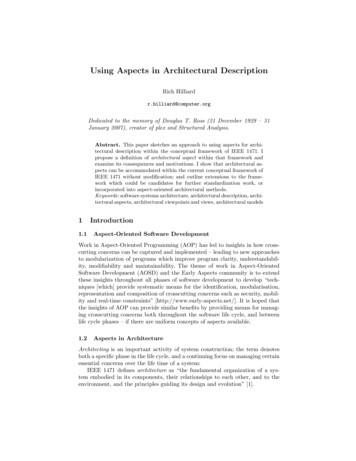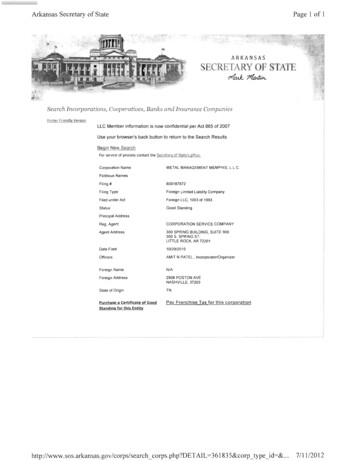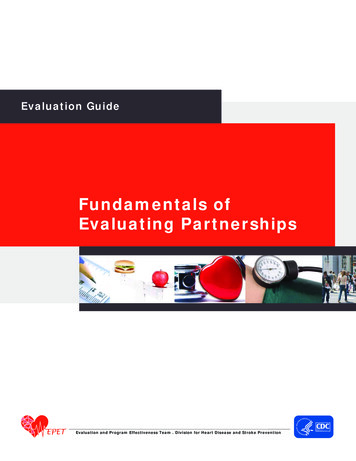
Transcription
2019 ARCHITECTURAL MANUAL APPENDIX IARCHITECTURAL STANDARDSTABLE OF CONTENTSI.INTRODUCTIONII.DESIGN SUBMITTALS AND CONSTRUCTION MONITORINGA.Drawings and SpecificationsB.Building PermitsC.Soils & Materials TestingD.Construction MonitoringIII.SITE DEVELOPMENT STANDARDSA.Environmental ConditionsB.ParkingC.Vehicle CirculationD.Pedestrian CirculationE.Open SpacesF.LandscapingG.Site LightingH.Site AmenitiesI.Trash CollectionJ.Signage and FixturesK.Site Grading and DrainageL.SecurityM.Site UtilitiesIV.BUILDING EXTERIOR DESIGN STANDARDSA.RoofingB.Gutters and DownspoutsC.Exterior Claddingi.Brickii.Insulated Vinyl Sidingiii.Fiber Cement/Cementitious Sidingiv.Natural or manufactured stonev.Other MaterialsD.Exterior Doors and WindowsE.Exterior StairsV.BUILDING INTERIORS DESIGN STANDARDSA.Room ConfigurationB.Unit SizesC.Minimum Unit SizesD.Kitchen RequirementsE.ClosetsF.Ceiling HeightsG.Floor FinishesH.Additional RequirementsI.AppliancesJ.MechanicalK.Electrical, Plumbing, and Indoor Air QualityL.Electrical2019 Architectural StandardsPage 1 of 11
M.N.O.Acoustical IsolationThermal InsulationRadonVI.FIRE AND LIFE SAFETYVII.ACCESSIBILITYI. INTRODUCTIONIn accordance with federal requirements established by 24 CFR 92.25 (HOME), IRC Section 42(LIHTC), and the 1989 Georgia General Assembly Housing Trust Fund (HTF) for the Homeless,the Georgia Department of Community Affairs (DCA) has established these ArchitecturalStandards. All projects receiving DCA resources for the construction of new and/or rehabilitationof existing rental housing, including HOME, 9% LIHTC, 4% LIHTC/Bonds, and/or Housing TrustFund (HTF), must meet these Architectural Standards. The Project Team is responsible forensuring 100% compliance with this Manual (and approved DCA Architectural Waivers).The Qualified Allocation Plan requires that projects funded under the Plan meet applicableFederal, State, and DCA codes, acts, and regulations. These architectural standards donot replace Federal, State or local codes. These standards are in addition to the following: Georgia State Minimum Standard Codes (with Georgia Amendments)International Building Codei.International Energy Conservation Codeii.International Fire Codeiii.International Fuel Gas Codeiv.International Mechanical Codev.International Plumbing Codevi.International Residential Codevii.National Electrical Codeviii.HUD Housing Quality Standards (HQS)HUD Minimum Property Standards (MPS)HUD Uniform Physical Condition Standards (UPCS).The Qualified Allocation Plan requires that all projects funded under the Plan meet all applicablefederal and state accessibility standards as well as all DCA accessibility requirements.This Architectural Standards document, in addition to the QAP and Rehabilitation Standards,contains more on materials longevity and component replacement requirements.DCA may determine that projects which exceed customary and reasonable construction costs,even if within published per unit cost limits, represent an inappropriate use of resources andmay fail Threshold.Applicants must submit all waivers at the pre-application stage. Refer to the relevant 2019 DCAguides and manuals for further guidance. The Applicant must demonstrate efforts to meet theminimum design criteria.Waiver requests for accessibility related items must include a legal opinion, clearance letter ofapproval from accessibility consultant, and information (i.e. feasibility analysis, site conditions,etc.) that could justify a waiver, as outlined in DCA QAP and manuals. DCA cannot waive itemsrequired by Federal and State law. Refer to the 2019 DCA Accessibility Manual for furtherguidance.2019 Architectural StandardsPage 2 of 11
For any project using HOME funds, a Pre-construction Conference must be scheduled priorto construction commencement to review federal compliance requirements and draw requestprocedures. Also, monthly onsite OAC Meetings must be scheduled and notifications sent tothe DCA Construction Project Manager via email about OAC meetings dates and times.II. DESIGN SUBMITTALS AND CONSTRUCTION MONITORINGA. Drawings and Specifications:Construction documents, including architectural drawings and specifications, are requiredfor both new construction and rehabilitation projects. Architectural drawings and specificationsmust meet industry standards, be clear and consistent, and realistically depict the project’sdesign, location, and dimensions. Refer to the Architectural Submission Requirements fordocument format and submittal requirements.B. Building Permits:All DCA program-funded work requires building permits. Proof of inspections and approvals bylocal officials, including Certificates of Occupancy, are required for final allocation of Low IncomeHousing Tax Credits (LIHTC). See Architectural Submission Requirements and contact DCALIHTC and HOME underwriters for specific information.C. Soils and Materials Testing:Test all new soils and structural concrete to ensure compliance with engineeredspecifications. Test additional materials as dictated by industry standards. A licensed andstate accredited testing lab, using standardized testing procedures, must conduct these tests.D. Construction Monitoring:DCA will monitor construction to ensure quality standards and completion dates throughinspection reports and other sources. Reports will address construction methods, constructiondraw requests, percentages of completion, progress and budget analysis, and adherence tocodes and standard building practices.For 4% bond and 9% projects only, the owner must reimburse DCA for constructionmonitoring cost, as described in Exhibit A (DCA Post Award Deadlines and Fee Schedule) ofthe Core QAP. For HOME projects, the Owner is billed the cost of the DCA constructionmonitoring.Periodically, DCA may require Owners to submit additional construction inspection reportsgenerated by construction managers, architects, and/or engineers. DCA reserves the right toinspect all properties prior to issuance of Final LIHTC Allocation. Make sure to correct noncompliance with building codes, accessibility codes, and/or DCA requirements before applyingfor the Final LIHTC Allocation. Refer to the QAP for further DCA and IRS requirements.III. SITE DEVELOPMENT STANDARDSA. Environmental Conditions:Carefully evaluate surrounding environmental conditions. Correct or alleviate negativeenvironmental conditions (i.e., ditches, canals, railroad tracks, expressways, noise sources,flood prone areas, etc.) through approved mitigation measures. Refer to the EnvironmentalPhase I Site Assessment standards published in the DCA Environmental Manual for theenvironmental documentation and review process. All applications are required to submit aPhase I Environmental Site Assessment and a Phase II investigation if recommended in thePhase I report.2019 Architectural StandardsPage 3 of 11
B. Parking:Parking spaces must meet local zoning requirements, unless otherwise approved by localmunicipalities with supporting documentation. In the absence of any other requirements, theremust be no less than 1.5 spaces per unit for family tenancy projects and 1 space per unit forsenior tenancy projects. Parking areas must be concrete, asphalt paving, or pervious pavement(porous asphalt, plastic grids, permeable interlocking concrete pavers, permeable clay brickpavers, resin-bound paving, bound recycled glass porous pavement) and have curbs.All handicapped parking spaces must meet federal and state accessibility requirements.All newly constructed handicapped parking spaces must be concrete paving and clearlydelineate accessible routes along the pavement surface (i.e. striping,). Please refer to the DCAAccessibility Manual for more information.C. Vehicle Circulation:For tenants, guests, and emergency services providers, design vehicle circulation routes toprovide safe ingress and egress to and from all buildings and amenities. Roads must beconcrete, asphalt paving, or pervious pavement (porous asphalt, plastic grids, permeableinterlocking concrete pavers, permeable clay brick pavers, resin-bound paving, bound recycledglass porous pavement) and have curbs and sidewalks.D. Pedestrian Circulation:Pedestrian circulation must be paved accessible routes to parking, buildings, and amenities.Streets (except crossing routes), grass and gravel/sand surfaces are not acceptablepedestrian circulation routes. Provide accessible ramps and no-step access, as applicable.E. Open Spaces:If there are open landscaped spaces or green belts they must be included in the overall sitedesign.F. Landscaping:Landscaping must be appropriate for the climate zone, appealing, and convey a residentialimage. Low maintenance plant materials are preferred. For appropriate landscape options,please refer to Landscape Plants for Georgia, published by the Cooperative Extension Service,The University of Georgia College of Agricultural and Environmental Sciences.G. Site Lighting:One foot-candle is the general standard for site lighting. All parking, building, amenity, and sitelighting must be sufficient for its purpose (i.e. evening mail collection, etc.), and be directeddown to diminish nuisance light. Additionally, units must have exterior entry and porch doorlights controlled from within the unit.H. Site Amenities:Standard and additional selected amenities must meet applicable federal, state, and DCAaccessibility requirements and the DCA Amenities and Accessibility Manuals. Locate siteamenities, such as the playground, in centrally visible locations while other noise proneamenities may be appropriately sited on the property.Standard and additional selected site amenities identified in the application submission must bein the final construction documents and budget.I. Trash Collection:Screen trash collection sites from residential and community areas and place at a distancefrom the tenant dwelling units and amenities that minimizes objectionable sights and odors.2019 Architectural StandardsPage 4 of 11
The collection areas must be accessible to disabled persons while convenient to tenantsand service vehicles. Place dumpsters on concrete slabs with concrete approach aprons atleast 10’-0” in depth.J. Signage and Fixtures:Building signage must meet the requirements of local 911 service providers. Illuminate theproperty entrance sign.K. Site Grading and Drainage:Site grading and positive drains must direct storm water away from buildings and site amenitieswhile eliminating pooling, puddling, etc. All on-property retention and detention areas must befenced and, for maintenance and safety purposes, a properly securable gate may beprovided.Design inlet or outlet drainage ways to prevent resident entry. Maintain on-property retentionponds. Foundation walls must prevent the entrance of water, insects, and rodents into thebasement or crawl space areas. Access and ventilation of basement and crawl spaces mustmeet code requirements and be secured from the exterior as appropriate.L. Security:. As necessary, incorporate security measures, such as: Define property lines and private areas with landscaping, post-and-pillar fencing,pavement treatments, architectural features, and/or signage.Keep shrubbery lower than 3’ under windows and 2’ for groundcover, and trees clearedat least six feet up. Keep fences low or not opaque.Avoid creating blind spots or hiding places, such as near dumpsters.Site exterior doors to be pedestrian friendly and visible from the street or neighbors.Install security cameras and HVAC cages.Unit entry doors must be equipped with a viewer and bell or buzzer.All doors must have hardware that complies with ANSI/BHMA Standards.o Exterior doors and windows must be equipped with automatic locks to preventaccess from the outside.M. Site Utilities:All utility distribution systems must be underground where possible. All projects must haverequisite access and connectivity to the existing public utilities. Refer to the Qualified AllocationPlan, Appendix I, and Threshold Criteria for more information.IV. BUILDING EXTERIOR DESIGN STANDARDSBuilding exteriors must create a residential image appropriate to the market. DCA encouragesthe use of materials that provide low maintenance and longevity for the life span of the property.All materials are to be installed using standard construction methods and means, and result inthe issuance of manufacturers guarantees.A. Roofing:Anti-fungal dimensional (architectural) shingles with a minimum 30-year warranty are requiredfor all shingle roof applications. Flat roofs are not encouraged, but DCA will allow flexibility inroof design if it is part of an energy conservation green building component or a roof design thatmimics existing contextual surroundings. Applicants must obtain DCA pre-approval before using2019 Architectural StandardsPage 5 of 11
one of these alternatives. All edges of the roof must have an aluminum drip edge that extends aminimum 3” under the shingles, 2” onto the fascia and have a minimum ½” 45 degree kick outat the bottom end of the fascia extension.B. Gutters and Downspouts:Seamless gutters and downspouts are mandatory for all construction and on all buildings.C. Exterior Cladding:1. Brick: See Appendix I, Threshold Criteria, Architectural Design & Quality Standards,Qualified Allocation Plan.2. Insulated vinyl siding must be impact resistant commercial grade with a minimumthickness of .046” and a minimum 30-year manufacturer warranty and must meet orexceed ASTM D3679 & ASTM D7856 standards.3. Fiber Cement/Cementitious Siding must be 5/16” nominal thickness with a 30-yearmanufacturer warranty.4. Natural or manufactured stone.5. Other materials: The use of exterior insulation and finish systems (EIFS), and stuccomust be pre-approved by DCA prior to application submission. Wood siding is notpermitted. All exterior trim, including fascia and soffits, window and door trim, gablevents, etc. must also be constructed of no or very low maintenance materials. Vinylsoffit must be commercial grade with a minimum thickness of .046” and a minimum30-year manufacturer warranty. Completely cover wood fascia with prefinishedaluminum with a .024” minimum thickness.Where exterior brick does not extend to an eve line, aluminum flashing must be installedthat extends a minimum of 2” under/behind the above exterior wall surface material andover the outer edge of the brick to prevent water penetration.D. Exterior Doors and Windows:1. Exterior doors must be 1 ¾” high durability, insulated (such as steel or fiberglass) andmeet the requirements of the Georgia State Minimum Standard Codes and Amendments.2. All primary entries must be in a breezeway or have a minimum 3’ deep by 5’ roof covering,and a corresponding porch or concrete pad.3. Exterior doors for fully accessible units must include spring hinges.4. Window and door glazing must meet the requirements of the Georgia State MinimumStandard Codes and Amendments.5. Wood windows and exterior entry doors are not permitted.6. Windows must not be located within a shower surround area or over shower units.7. Install a continuous bead of silicone caulk behind all nail fins before installing newwindows per manufacturer’s specifications.8. Skylights, windows and locations, sizes and operable panels must meet therequirements of the Georgia State Minimum Standard Codes and Amendments.E. Exterior Stairs:All exterior stairs must be covered and protected from the elements in new and rehabilitationbuildings.V. BUILDING INTERIORS DESIGN STANDARDSA. Room Configuration:Room configuration must be functional while providing economic use of space:2019 Architectural StandardsPage 6 of 11
1. The primary bathroom must be accessible from a common area such as a hall.Exceptions may be considered for one-bedroom unit rehabilitations.2. The kitchen must be accessible from the entry.3. Bathrooms must not open from areas of food preparation or be used as a solepassageway to a habitable room, hall, basement, or the exterior.4. No habitable rooms are permitted in basement or cellar spaces unless egress isprovided according to applicable fire codes.5. All windows in bedroom units must comply with all local and state life safety requirements.DCA will consider windowless bedrooms with an architectural standards pre-applicationwaiver and documentation showing approval of such by the local code official and/or StateFire Marshal.B. Unit Sizes:The following criteria are the minimum requirements:Net Rentable (Leasable) Square FootageThe unit net rentable area is calculated for each individual dwelling type and measured from theinside face of each of the unit’s perimeter walls. DCA’s definition as it pertains to the QAP andrelated documents is as follows:1.2.3.4.5.6.Net area includes air-conditioned space only.Measure from the inside (paint) face of all unit perimeter walls.Do not include any patio, balcony, or breezeway areas.Do not include any outside storage closets.Do not deduct any interior walls.Include non-revenue units in total net rentable living area (Total Residential Unit SquareFootage)C. Minimum Unit SizesDWELLING TYPEStudioMINIMUM SQUAREFOOTAGE375KITCHENBATHROOMCooking area1Efficiency450Full kitchen11 bedroom650Full kitchen12 bedroom850Full kitchen11,100Full kitchen23 bedroom ( )D. Kitchen RequirementsUNIT TYPEMINIMUM CLEARCOUNTERTOPFRONTAGEMINIMUM LINEAR FOOTAGEOF CABINETS(includes base & wallcabinets, pantries,combined)1 bedroom6’-9”162 bedroom7’-9”183 bedroom ( )8’-9”202019 Architectural StandardsPage 7 of 11
E. Closets1. Provide a suitable number of closets for each dwelling unit. .2. All closets designed to contain clothes must be a minimum of 2'-0" deep.3. Closets and defined storage areas must not be included in the room area square footagecomputations.4. Closets and storage spaces in accessible units must meet applicable reach rangerequirements.F. Ceiling Heights1. Flat ceilings must be a minimum of 8’-0” above finished floor.2. Sloped ceilings must not be less than 5’-0” for the purposes of computing floor areas.3. Ceiling heights must meet minimum requirements established by the Life Safety Code andthe Georgia State Fire Marshal’s Office.G. Floor Finishes:Floor finishes must be the following or better. Living Areas and Bedrooms: Carpet or LVT Bathrooms, Mechanical Closets, Laundry Areas, Kitchen and other high moisture areas:Sheet Vinyl, VCT, LVT or Ceramic Tile.DCA will evaluate kitchen and living room flooring materials for appropriate marketability,durability, sound transmission, and tenant comfort.Install all materials to manufacturer’s specifications by standard methods and receive amanufacturer's guarantee. DCA may approve material upgrades with improved maintenancequalities, durability, safety and/or indoor air quality for the tenants. The Owner must receivemanufacturer’s warranties from the General Contractor.1. Carpet: Unit carpeting may have a level loop, textured loop, level cut pile, or levelcut/uncut pile texture. DCA may approve alternate carpeting materials and installationmethods in units intended for the elderly or disabled. Carpeting must comply with HUD’sUse of Materials Bulletin No. 44d.2. Install the intended carpet pad under all carpeting and in compliance with HUD’s Use ofMaterials Bulletin No. 72a.3. Sheet vinyl must be a minimum 0.095” thickness and provide a 20-year residentialwarranty.4. Ceramic floor tile must be minimum 12” x 12” and installed over poured concrete slab orcementitious backing material.5. VCT must be at minimum 0.080” thickness.6. Luxury Vinyl Tile (LVT) must have a 12mil wear layer and provide a 15-year residentialwarranty. LVT installed in kitchens, bathrooms, laundry areas and mechanical closetsmust be 100% waterproof.H. Additional Requirements:1. Bathrooms must have adequate storage. Medicine cabinets can supplement storagespace. Do not place medicine cabinets in party walls unless fire separation is continuousbehind and around the cabinet installation.2019 Architectural StandardsPage 8 of 11
2. Install plastic laminate material the full width and depth of the bottom shelf of vanity sinkcabinets and kitchen sink cabinets. Installation must be sealed/caulked around the fullperimeter to all cabinet sides to prevent moisture/water penetration.3. Construct kitchen countertops of a 3/4” plywood base with laminate top or solid surfacematerial. No particle board, press board or fiber board will be allowed.4. Seal all open voids above and below upper and lower kitchen cabinets with caulk orcabinet matching material/finish. Caulk all cabinets where the cabinet meets a wallsurface to prevent pest infestation. No open voids will be allowed. Seal all openvoids/holes in cabinet backs with matching cabinet material, caulk or expandable foamand all pipe penetrations must be covered with an escutcheon.5. Provide kitchen cabinets above and below countertops. Construct cabinets with solidwood or plywood boxes, stiles, rails, doors and drawer fronts. All cabinets must conformto the performance and fabrication requirements of HUD Severe Use and ANSI/KCMAA161.1 and bear the KCMA Certification Seal. No particle board, press board or fiberboard will be allowed.6. All windows must have neutral color horizontal mini-blinds. All glass doors must haveeither mini-blinds or vertical slat blinds.7. Provide cable outlets in the main living area and in all bedrooms. Provide oneinternet router outlet.8. All interior finishes, especially interior paint, must be low in Volatile Organic program(http://www.earthcraft.org/multifamily).9. In new construction and adaptive re-use projects, all water heater tanks must be placedin an overflow pan piped to the exterior of the building, regardless of location and floorlevel, unless a primed p-trap is installed. Pipe the temperature and relief valve to theexterior. Place water heaters in closets to allow for their removal and inspection by orthrough the closet door. Do not install water heaters over the clothes washer or dryerspace.10. Bathroom shower walls must be either ceramic tile, solid surface material, one-piecefiberglass tub/shower enclosure or one-piece fiberglass shower enclosure. Install ceramicwall tile over cementitious backing material.11. All dwelling units must have washer and dryer hookups.I. Appliances:All units must include: microwaves refrigerators with ice maker (14 ft.4 minimum for one and two bedroom units; 16 ft.4minimum for three bedroom units) ranges dishwashers (except in senior USDA or HUD properties)Kitchen appliance sizes must be appropriate for the unit and number of tenants. Provideappropriate appliances as listed in US EPA’s Energy Star program. Further information isavailable at http://www.energystar.gov/.2019 Architectural StandardsPage 9 of 11
In-unit washers must be equipped with a drain pan or floor drain, as required by the GeorgiaState Minimum Standard Codes and Amendments. Owner-furnished washers in mobility unitsand community laundries must be front-loading and Energy Star rated.J. MechanicalMechanical system equipment must meet the requirements of the Georgia State MinimumStandard Codes and Amendments.K. Electrical, Plumbing, and Indoor Air Quality:The minimum requirements for this section are located in Appendix I, Threshold Criteria,BUILDING SUSTAINABLITY, Qualified Allocation Plan.L. ElectricalMinimum panel size for electrical distribution systems are 100 amps, or per code. Electricalswitches, outlets, thermostats, phone and television jacks and other controls are to be installedper Fair Housing Act Design Manual requirements in qualified units and per appropriateaccessibility law in accessible units. All penetrations of smoke partitions and rated assembliesmust comply with local fire codes.M. Acoustical Isolation:Acoustical isolation requires a minimum STC rating of 52. Acoustical isolation surpassing therequired minimums will increase unit quality. Noise levels on funded properties must meet DCAand HUD noise limitations: Exteriors:Interiors:65 dB45 dBIn areas where daytime/nighttime noise levels are above these limitations, documentation ofthe construction and mitigation methods must accompany the application for funding.The following minimum standards apply:1. Between units: 1 hr. rated UL assembly with one layer 5/8” GWB on each side (minimumor per local fire requirements if greater) with two sets of staggered 2x4 studs (or metalstud equivalent), sound-insulated with blanket material to STC rating of 52. All walledges must be caulked2. Within unit: one layer ½” GWB on each side 2x4 studs (or metal stud equivalent)3. Floor to floor: 1 hr. rated UL assembly with a minimum STC rating 52. A minimum of 1”lightweight concrete or ¾” gypcrete topping over wood sub floor (optional floorconstruction may be considered for the rehabilitation of existing residential units).N. Thermal Insulation:Thermal insulation must meet minimum standards as defined in Georgia State MinimumStandard Energy Code (International Energy Conservation Code). O. Radon:Build all new construction in accordance with current EPA requirements for radon resistantconstruction techniques, including, but not limited to, ASTM E1465 – 08a Standard Practice forRadon Control Options for the Design and Construction of New Low-Rise Residential Buildings.Test new construction and rehabilitated buildings, prior to tenant occupancy, for compliancewith EPA’s established radon level limits. For rehabs with rolling or scattered relocation, submitradon testing and reports at project completion.2019 Architectural StandardsPage 10 of 11
VI. FIRE AND LIFE SAFETYThe property design must provide a safe environment for all tenants. Projects must adhere tothe most recently adopted editions of the Georgia State Minimum Standard Codes andAmendments and to local requirements (fire department, code, and other authorities). Thisincludes but is not limited to the following:A. Smoke detectors must be hard-wired and located per code for all construction. DCA willnot waive this requirement for rehabilitation proposals. Carbon Monoxide Detectors mustbe in accordance with NFPA 101 Life Safety Code and NFPA 720.B. Fire alarms and sprinklers.C. Attics must be constructed or rebuilt to include draft stop walls, and rated ceiling, floor, andwall assemblies.D. All through-penetrations of smoke walls, draft stops, and rated assemblies.Disaster mitigation-related requirements.VII. ACCESSIBILITYDesign the Property to meet all applicable federal, state, local and DCA requirements foraccessibility by the disabled. Incorporate the accessibility characteristics in the layout anddesign of open spaces, building locations and unit designs. Refer to the "2019 DCAAccessibility Manual" for additional information. Projects receiving DCA funding must meetfederal, state and local accessibility laws and meet the requirements of the DCA 2019 QAP andthe 2019 DCA Accessibility Manual. Please note that DCA requirements may be more stringentthan federal or state requirements.2019 Architectural StandardsPage 11 of 11
2019 Architectural Standards Page 5 of 11 The collection areas must be accessible to disabled persons while convenient to tenants and service vehicles. Place dumpsters on concrete slabs with concrete approach aprons at least 10’-0” in depth. J. Signage and Fixtures: Building signage must











